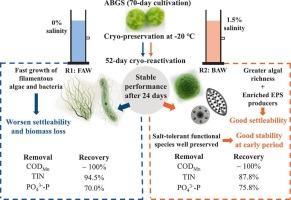冷冻藻菌颗粒污泥用于微咸养殖废水处理系统快速启动的可行性及性能
Q1 Environmental Science
引用次数: 0
摘要
本研究评估了使用冷冻(- 20°C)来保持藻菌颗粒污泥(ABGS)中耐盐功能物种的活力和功能的可行性,以快速启动处理微咸水产养殖废水(BAW)的工艺。在低温活化过程中,经过24 d的适应,R1(淡水养殖废水,FAW)和R2 (BAW)均获得稳定的性能,其冷冻前高锰酸盐指数(CODMn)去除效率恢复近100%。R1处理恢复了冻结前总无机氮(TIN)去除率的94.5%和PO43−p去除率的70.0%,R2处理分别恢复了87.8%和75.8%。丝状微生物(如norank_f__Saprospiraceae, Leptothermofonsia和Jaaginema)的快速生长导致R1颗粒沉降性恶化和随后的生物量损失。相比之下,R2表现出良好的颗粒稳定性和沉降性,尽管其生物量积累速度较慢。ABGS在R2中具有良好的沉降性,这可归因于分泌eps的细菌(Proteobacteria)的富集和藻类的丰富度。参与有机碳代谢、除磷和硝化反硝化的关键耐盐细菌在R2中得到了很好的保存。低温再激活作为一种快速启动ABGS工艺处理BAW的策略显示出潜力,尽管需要进一步优化以确保完全恢复功能。本文章由计算机程序翻译,如有差异,请以英文原文为准。

Feasibility and performance of frozen algal-bacterial granular sludge for rapid startup of brackish aquaculture wastewater treatment system
This study assessed the feasibility of using freezing (−20 °C) to preserve the viability and functionality of salt-tolerant functional species in algal-bacteria granular sludge (ABGS) for the rapid startup of processes treating brackish aquaculture wastewater (BAW). After 24 days of adaptation during the cryo-reactivation, both R1 (fresh aquaculture wastewater, FAW) and R2 (BAW) achieved stable performance and nearly 100 % recovery of their pre-freezing permanganate index (CODMn) removal efficiencies. R1 restored 94.5 % of the pre-freezing total inorganic nitrogen (TIN) removal level and 70.0 % of the PO43−-P removal level, while R2 regained 87.8 % and 75.8 % of these levels, respectively. The rapid growth of filamentous microorganisms (e.g., norank_f__Saprospiraceae, Leptothermofonsia, and Jaaginema) led to worsening of granule settleability and subsequent biomass loss in R1. In contrast, R2 exhibited good granule stability and settleability, despite its slower biomass accumulation rate. The good settleability of ABGS in R2 can be attributed to the enrichment of EPS-secreting bacteria (Proteobacteria) and greater algal richness. Key salt-tolerant bacteria involved in organic carbon metabolism, phosphorus removal, and nitrification-denitrification were well preserved in R2. Cryo-reactivation shows potential as a strategy for the rapid startup of ABGS processes for BAW treatment, although further optimization is needed to ensure complete functional restoration.
求助全文
通过发布文献求助,成功后即可免费获取论文全文。
去求助
来源期刊

Bioresource Technology Reports
Environmental Science-Environmental Engineering
CiteScore
7.20
自引率
0.00%
发文量
390
审稿时长
28 days
 求助内容:
求助内容: 应助结果提醒方式:
应助结果提醒方式:


